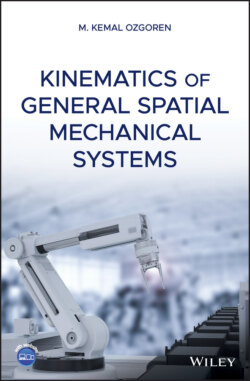Читать книгу Kinematics of General Spatial Mechanical Systems - M. Kemal Ozgoren - Страница 44
2.9.3 Determination of the Axis of Rotation
Оглавление1 (a) General Case with sin θ ≠ 0
In a general case such that sin θ ≠ 0, Eqs. (2.125)–(2.127) give the components of as follows:
(2.134)
(2.135)
(2.136)
1 (b) Special Cases with sin θ = 0
However, if sin θ = 0, then Eqs. (2.125)–(2.127) cannot give the components of . There are three distinct cases, in which sin θ = 0. These cases are discussed below by considering θ to be in the minimal rotation range, without any loss of generality. This range is defined so that 0 ≤ |θ| ≤ 2π.
1 Special Case with No Rotation
In this case, θ = 0 and becomes indefinite. Indeed, if there is not any rotation at the moment, then represents any arbitrary unit vector that forms the axis of a prospective rotation, which is yet unknown.
1 Special Case with Full Rotation
In this case, θ = ± 2π and becomes indefinite again. Indeed, after a full rotation, a rotated vector comes back to its initial orientation no matter what the rotation axis is. In other words, according to the mathematical property expressed by Eq. (2.68) in Section 2.7, the following equation is satisfied for any arbitrary .
(2.137)
1 Special Case with Half Rotation
In this case, θ = ± π. However, unlike the first two cases, does not become indefinite in this case, even though it cannot be found from Eqs. (2.125)–(2.127). Indeed, after a half rotation of a vector, the bisector of the angle between the initial and final orientations of the vector coincides with the rotation axis. This fact is illustrated in Figure 2.2 for two different half rotations of the same vector. Owing to this fact, happens to be definite and therefore it can be found somehow, e.g. as explained below, if not from Eqs. (2.125)–(2.127).
In the case of a half rotation, with sin θ = 0 and cos θ = − 1, Eqs. (2.116)–(2.124) reduce to the following forms.
(2.138)
(2.139)
(2.140)
(2.141)
(2.142)
(2.143)
Equations (2.138)–(2.140) provide the components of as follows with three arbitrary sign variables, which are σ1 = ± 1, σ2 = ± 1, and σ3 = ± 1:
(2.144)
(2.145)
(2.146)
However, the three sign variables are not independent from each other because the components of obtained above must also satisfy Eqs. (2.141)–(2.143). Here, another set of three cases arises depending on whether all the components of are nonzero or not.
Figure 2.2 Half rotations of the same vector about different axes.
Case 1: All the components of are nonzero.
In this case, Eqs. (2.141)–(2.146) imply the following sign variable equations.
(2.147)
(2.148)
(2.149)
When two of the preceding three equations are multiplied side by side, the following additional equations are obtained by noting that .
(2.150)
(2.151)
(2.152)
Hence, it is seen that Eqs. (2.150)–(2.152) provide the three sign variables as follows in terms of a single arbitrary sign variable σ′ = ± 1.
(2.153)
(2.154)
(2.155)
Case 2: One of the components of is zero.
Let ijk ∈ {123, 231, 312} and suppose that nk = 0, while ni ≠ 0 and nj ≠ 0. In such a case, Eqs. (2.138)–(2.143) imply that rik = rki = rkj = rjk = 0, rkk = − 1, and
(2.156)
Equation (2.156) can be satisfied if σi and σj are expressed as follows in terms of a single arbitrary sign variable σ′ = ± 1:
(2.157)
(2.158)
Case 3: Two of the components of are zero.
Let ijk ∈ {123, 231, 312} again and this time suppose that ni = nj = 0, while nk ≠ 0. In such a case, Eqs. (2.138)–(2.143) imply that rkk = + 1, rij = rji = rjk = rkj = rki = rik = 0, and rii = rjj = − 1. Then, as the only nonzero component,
(2.159)
